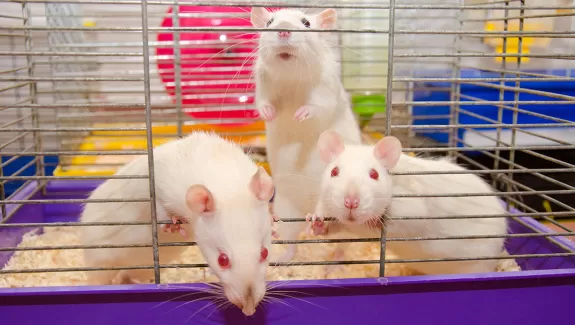
Professional Development through Animal Research
Author: Vincent Bello
Behavior analysis today gets most of its mainstream recognition for the work being done in applied settings, referred to as applied behavior analysis (ABA). The progress of behavior analytic applications has been important for the dissemination of the science and even better for the clients across the world who require behavioral services. As a result, it is no surprise that more research than ever is being conducted in clinics, homes, schools, organizations, and other places where human behavior can be improved.
While the focus on applied areas of behavior analysis has increased over the last half century, the same cannot be said for other areas, such as basic research. Basic research, referred to as the Experimental Analysis of Behavior (EAB), is a subdiscipline of behavior analysis that focuses on investigating basic behavioral phenomena. This type of foundational research was once the primary endeavor of behavior analysts throughout the early development of the field but has since received increasingly less attention as demand for applied services has risen. As a result, many behavior analysts today find themselves on the front lines of behavioral service delivery, using the procedures and technologies developed through basic research before actually researching the basic principles and procedures themselves.
Despite this shift toward applied areas, a number of universities and research institutions continue to conduct basic research that is necessary to expand our understanding of behavioral phenomena. EAB laboratories conducting such research commonly do so using rats, pigeons, and other animals rather than human clients. Animal research may seem like it has little to do with the behavior of human beings, but the methods and findings from these labs ultimately inform how practitioners deliver behavioral services in applied settings. (For a more comprehensive discussion on how basic research informs applied research through translation (from a considerably more experienced behavior analyst) click here. Thus, participation in basic research may help behavior analysts develop a wide range of skills that are necessary to achieve client outcomes. Here is a list of four such skills:
1. Addressing extraneous variables
As behavior analysts, our primary job is to change the environment to increase or decrease (or possibly maintain) behavior. To achieve this goal, it is also important to identify and address extraneous variables—those that influence behavior but are not part of the intervention. Extraneous variables, when left unchecked, can have researchers and practitioners asking themselves, “We got behavior change, but how can we be sure that the intervention we implemented was responsible for those results and not something else?” If we don’t have an answer to this question, how can we know if we are benefiting our clients in the best way possible? In applied settings, identifying extraneous variables can be tricky, especially when we cannot directly access our clients’ home environments in which they spend a great deal of time.
 When working with rats and pigeons, the degree of control over the environment is considerably greater. Greater control results in clearer isolation of relevant variables which helps us analyze, and change, behavior as efficiently as possible. Basic researchers attempt to reach this level of control by managing countless variables inside and outside of the operant chamber. Some of these variables include the time of day each animal is put into the operant chamber, the amount and type of food given to each animal, the delay between experimental sessions and feeding, and the light and sounds within the operant chamber. Each variable is specifically arranged so that living and experimental conditions are consistent day in and day out. The result is that the researcher can say, with more confidence, that changes in behavior were due to changes in the experimental conditions, and not something else.
When working with rats and pigeons, the degree of control over the environment is considerably greater. Greater control results in clearer isolation of relevant variables which helps us analyze, and change, behavior as efficiently as possible. Basic researchers attempt to reach this level of control by managing countless variables inside and outside of the operant chamber. Some of these variables include the time of day each animal is put into the operant chamber, the amount and type of food given to each animal, the delay between experimental sessions and feeding, and the light and sounds within the operant chamber. Each variable is specifically arranged so that living and experimental conditions are consistent day in and day out. The result is that the researcher can say, with more confidence, that changes in behavior were due to changes in the experimental conditions, and not something else.
Even if you can’t control for each and every detail in applied settings, identifying extraneous variables and arranging experimental conditions accordingly can have huge effects on client results. If you find yourself in a tricky case where you can't seem to get the results your client needs, it could be that extraneous variables are changing behavior. Learning how to address these variables is a key skill in the repertoire of effective behavior analysts.
2. Delivering reinforcement effectively
Whether you are working with children with autism or with employees at a business, one thing you must be able to do as a behavior analyst is deliver reinforcement. Positive reinforcement, when administered effectively, is how we achieve behavior change and reach client goals. Conversely, delivering reinforcement “incorrectly” can have harmful effects on behavioral progress. Luckily, animal research provides a great opportunity for developing behavior analysts to practice reinforcement delivery, especially during procedures called magazine training and hand shaping.
 Magazine training is a procedure where an experimentally naïve (new to the operant chamber) rat or pigeon is first exposed to the feeding mechanism inside the operant chamber. The goal of magazine training is to pair the sound of the food dispenser with the actual delivery of the food. For the sound of the feeder to become a conditioned reinforcer, it is imperative that the sound and delivery of food be contiguous, or close in time. In applied settings, clients can respond quickly so it is extremely important to shape your skills delivering reinforcers as soon as you see a desired response. Reinforcing just a second or two late could actually reinforce a different behavior by mistake.
Magazine training is a procedure where an experimentally naïve (new to the operant chamber) rat or pigeon is first exposed to the feeding mechanism inside the operant chamber. The goal of magazine training is to pair the sound of the food dispenser with the actual delivery of the food. For the sound of the feeder to become a conditioned reinforcer, it is imperative that the sound and delivery of food be contiguous, or close in time. In applied settings, clients can respond quickly so it is extremely important to shape your skills delivering reinforcers as soon as you see a desired response. Reinforcing just a second or two late could actually reinforce a different behavior by mistake.
During a hand-shaping procedure, a magazine-trained animal is placed into the operant chamber. For rats, the operant chamber will commonly include an operational lever. For pigeons, a circular key will be inserted instead. Meanwhile, the experimenter watches through the plexiglass windows, armed with a controller to the food dispenser. The goal of hand shaping is to watch the animal interact with the operant chamber and deliver reinforcement for responses that are increasingly similar to the lever-press response. At first, you might have to start off reinforcing a wider range of responses, such as delivering food whenever the animal looks in the direction of the lever. Next, you might only reinforce the animal for making contact with the lever. Eventually, you are reinforcing the animal for more specific behaviors that are closer to lever pressing/key pecking. This sounds simple but delivering reinforcement is a skill that takes practice. All this practice will ultimately lead to some well-fed animals and will improve your reinforcement delivery skills with your clients.
3. Implementing punishment procedures
While reinforcement is the basis of many behavior-change interventions in applied settings, many sites rarely implement punishment procedures. Despite its limited systematic use, our clients face naturally occurring punishment contingencies all the time in clinics and schools and therefore it is important for behavior analysts to develop a conceptual understanding of the effects of aversive stimuli.
Due to the ethical and behavioral concerns of using punishment in applied settings, research on punishment is being conducted mostly in EAB labs with animals. As a result, these animal labs may be an ideal place for behavior analysts to learn about punishment and develop their implementation skills. Eventually, through continued research in basic settings, punishment procedures may be better understood in terms of their relation to human behavior. Until then, animal research labs are a great place for behavior analysts to learn more about punishment and gain valuable experience assessing punishment procedures.
4. Changing behavior without words
 By far one of the biggest lessons I learned from rats and pigeons is that learning does not require words, instructions, or rules. This can be difficult to truly appreciate when working with clients who have complex verbal repertoires. For these individuals, it is easy to tell them what we expect, or vice versa. Rats and pigeons do not, and cannot, learn through words. Yet, researchers have been able to shape extraordinary behavioral repertoires in animals. For example, Skinner was able to shape pigeons to play ping pong with each other. Researchers have even shaped rats to play basketball. In these cases, all the researcher needed to do to change behavior was deliver a simple food pellet at the correct time—perfect examples that remind us how consequences maintain behavior, and almost any behavior can be shaped.
By far one of the biggest lessons I learned from rats and pigeons is that learning does not require words, instructions, or rules. This can be difficult to truly appreciate when working with clients who have complex verbal repertoires. For these individuals, it is easy to tell them what we expect, or vice versa. Rats and pigeons do not, and cannot, learn through words. Yet, researchers have been able to shape extraordinary behavioral repertoires in animals. For example, Skinner was able to shape pigeons to play ping pong with each other. Researchers have even shaped rats to play basketball. In these cases, all the researcher needed to do to change behavior was deliver a simple food pellet at the correct time—perfect examples that remind us how consequences maintain behavior, and almost any behavior can be shaped.
What next?
No matter what setting or client population you are working with, gaining experience in animal research offers a unique professional development opportunity. You can learn many different skills conducting basic research while also deepening your conceptual understanding of basic principles. Here are a few ways you can get involved.
A great place to start familiarizing yourself with animal research is by reading articles from the Journal of Experimental Analysis of Behavior (JEAB). Reading a basic research article can be a fascinating change of pace from the applied literature. The implications and future research suggestions in basic and translational research articles can be a great place for new ideas, especially for applied settings. Attending a basic/animal research-based presentation at your next behavior analytic conference is also a great starting point. Listening to a presentation is another great source for new research ideas and descriptions of different research methodologies that don’t require you to read through a dense method section.
An additional option to obtain simulated animal research experience is through Sniffy the Virtual Rat. Downloadable for kindle and other devices, Sniffy is an application that depicts simulated experiments within an operant chamber. As the user, you get to interact with Sniffy and design operant experiments. In full disclosure, Sniffy the Virtual Rat has mixed reviews in terms of its user experience, but free lite versions of the application are available from multiple websites. It could be worth further exploration.
Finally, I’d highly suggest that anyone interested in gaining direct experience conducting animal research reach out to a reputable program for more information. Especially for undergraduates or non-behavior analysts interested in pursuing a higher degree in our field, contacting behavior analysts at your university for additional resources would be a great place to start your journey.









